Visit Guwahati For A Excellent Weekend Getaway In 2025
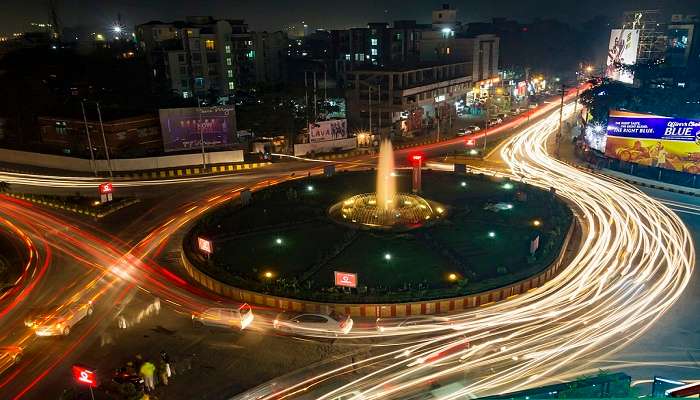
Nestled in the heart of Assam, Guwahati is a vibrant city. As the gateway to Northeast India, it is a crucial cultural and economic hub for the region. Straddling the mighty Brahmaputra River, Guwahati boasts a rich history dating back to ancient times, evident in its numerous temples and archaeological sites. Today, the city pulsates with energy, offering visitors a unique blend of natural beauty, spiritual significance, and urban amenities.
History Of Guwahati
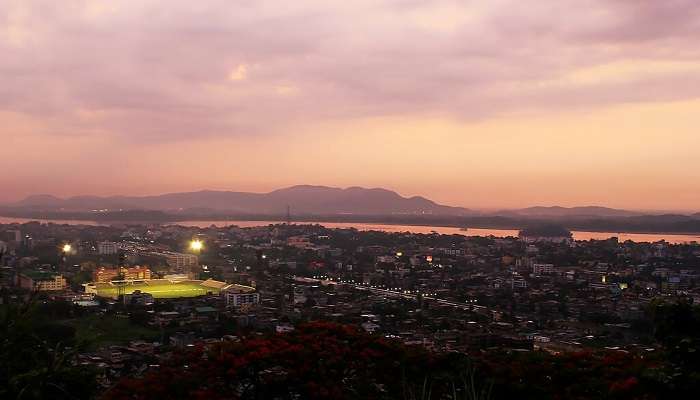
Guwahati, the largest city in northeastern Assam, India, holds a rich historical legacy dating back centuries. It is often called the “Gateway to Northeast India” due to its strategic location and historical significance. The city’s name, Guwahati, is derived from the Assamese words “Guwa” (meaning areca nut) and “Hati” (meaning rows), referencing the rows of areca nut trees that once lined the banks of the Brahmaputra River.
Ancient texts like the Kalika Purana and Yogini Tantra mention Guwahati as part of the ancient state of Kamarupa, with its capital at Pragjyotishpura. The city flourished during the rule of the Varman and Pala dynasties, which is evident from archaeological sites like Ambari and temple complexes such as Kamakhya Temple, Umananda Temple, and Navagraha Temple. These landmarks highlight it’s importance as a centre of religious and cultural activities in the region. It is a bustling metropolis known for its cultural diversity, vibrant markets, and numerous temples. With a growing population and expanding urban landscape, it is an important economic hub and educational centre in Northeast India. The city continues to preserve its historical heritage while embracing modernity.
Must Read: Temples In Assam
Top Places To Visit In And Around Guwahati
Nestled on the banks of the mighty Brahmaputra River, Guwahati is a vibrant gateway to the natural and cultural wonders of Assam. From ancient temples to lush tea gardens, here are the top five places you must visit in and around this enchanting city.
1. Kamakhya Temple
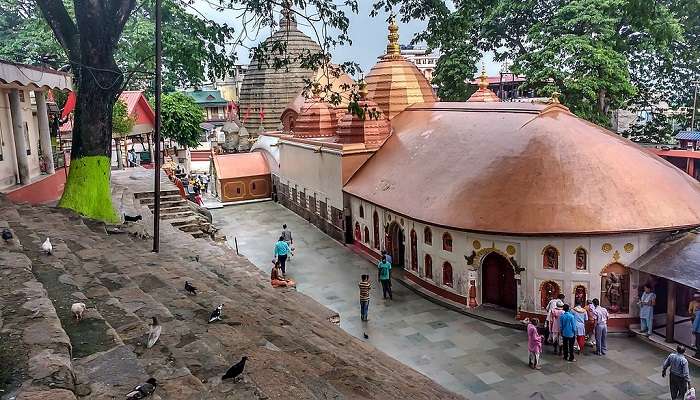
Situated atop Nilachal Hill in Guwahati, Assam, the Kamakhya Temple is a revered sanctuary and one of the oldest centres for Tantric practices. This ancient Shakti Peeth is dedicated to Goddess Kamakhya and is a significant pilgrimage site for both general Hindu devotees and practitioners of Tantra. The temple complex encompasses individual shrines devoted to various forms of the Divine Mother, including Bhuvaneshvari, Bagalamukhi, Chinnamasta, Tripura Sundari, and Tara.
The temple is also the heart of the Kulachara Tantra Marga. It hosts the Ambubachi Mela, an annual festival commemorating the goddess’s menstruation. Visitors are often captivated by the temple’s unique beehive-like shikhara and beautifully sculptured panels.
Location: 5P87+558, Kamakhya Mandir Rd, Nursery, Guwahati, Assam 781010
Distance From Guwahati: 6.3 Km
Travel Time From Guwahati: 10 minutes
2. Umananda Island
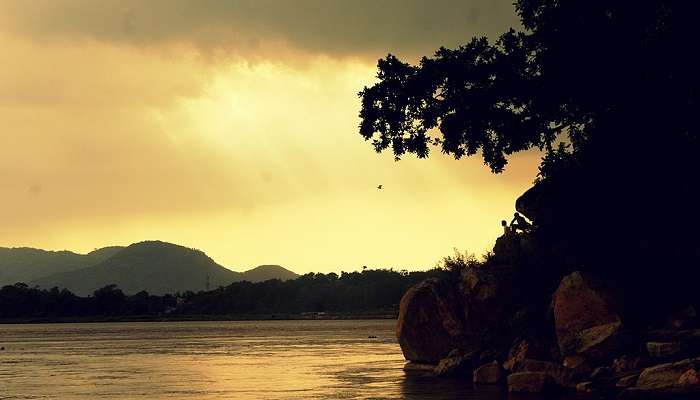
Umananda Island, often called “Peacock Island,” is a petite island nestled in the Brahmaputra River in Assam. The island is renowned for the holy Umananda Temple, a shrine dedicated to Lord Shiva. The island is steeped in history and religious importance, with local folklore suggesting that it was here that Lord Shiva shared wisdom with his consort, Parvati.
The island was once a habitat for the endangered golden langur. Visitors can reach it by ferry, which takes a 10-minute ride from Umananda Ghat, near the Guwahati High Court. With its rich historical background, stunning landscapes, and fascinating tales, Umananda Island is indeed a sacred and mesmerising destination.
Location: Baruah Souk, North Guwahati, Guwahati, Assam 781030
Distance From Guwahati: 16.3 Km
Travel Time From Guwahati: 31 minutes
Suggested Read: Places To Visit In Guwahati For Couples
3. Guwahati Zoo
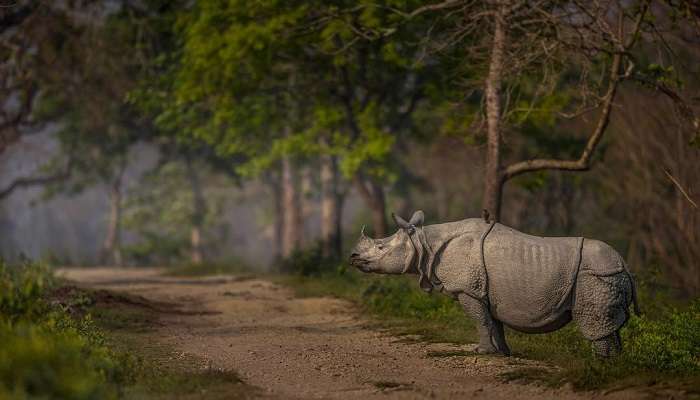
Covering over 430 acres, Guwahati Zoo (Assam State Zoo cum Botanical Garden) is the biggest zoo in India’s northeast. Founded in 1958, it’s nestled within its Hengrabari Reserved Forest. This place is a haven for animal lovers, with over 1125 creatures representing 115 species from worldwide. One can see the mighty one-horned rhino, playful tigers, or orangutans swinging through the trees.
Birdwatchers will love the dedicated area showcasing a variety of feathered friends. Additionally, the botanical garden within the zoo boasts an impressive collection of rare and indigenous plant species, making it a paradise for botanists and nature enthusiasts alike. With its rich wildlife and lush greenery, Guwahati Zoo offers a perfect escape into nature’s wonders for visitors of all ages.
Location: RG Baruah Rd, Guwahati, Assam 781005
Distance From Guwahati: 15.3 Km
Travel Time From Guwahati: 45 minutes
4. Assam State Museum
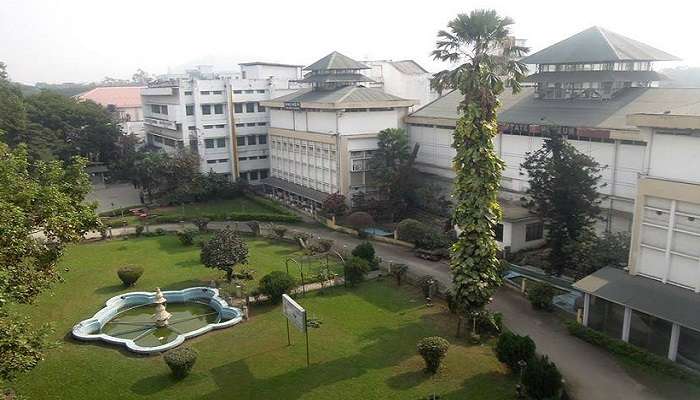
The Assam State Museum, nestled in the heart of Guwahati city, is a historical and cultural gem. Previously known as the Assam Provincial Museum, it was established by the Kamarupa Anusandhan Samiti (Assam Research Society) in 1940. It was later taken over by the Assam State Government in 1953. The museum is a testament to the unique culture and tradition of the northeastern state.
The museum’s exhibits are organised into sections, including epigraphy, sculptures, miscellaneous, natural history, art and crafts, anthropology and folk art, and arms. These rare and valuable collections encompass stone, wood, metal, and terracotta sculptures from the Assam region.
Location: GNB Rd, near Dighalipukhuri, Mawhati, Ambari, Guwahati, Assam 781001
Distance From Guwahati: 18.4 Km
Travel Time From Guwahati: 38 minutes
Suggested Read: Places To Visit In Assam
Best Time To Visit Guwahati

The best time to visit Guwahati is from October to April. The weather is pleasant during these months, with temperatures ranging from 10°C to 25°C. This period encompasses autumn, winter, and early spring, providing ideal conditions for exploring the city’s attractions and engaging in outdoor activities.
October and November offer a serene atmosphere with fewer crowds, while March brings blooming landscapes and cultural festivities. The peak tourist season occurs during the winter months of December to February, attracting visitors with comfortable weather and vibrant cultural events.
How To Reach Guwahati

Guwahati, the largest city in the Indian state of Assam and a major gateway to the Northeast region, is well-connected by air, rail, and road, making it accessible from various parts of India. The ways to reach this place are as follows:
By Air
Lokpriya Gopinath Bordoloi International Airport (GAU) is the primary airport serving Guwahati. It is well-connected with major cities like Delhi, Mumbai, Kolkata, Bengaluru, and Chennai. The city centre is about 25 kilometres from the airport and can be reached by taxis, app-based cabs, and buses.
By Rail
Guwahati Railway Station (GHY) is a major railhead in Northeast India. It is connected to major cities nationwide through various express and superfast trains, including Delhi, Kolkata, Mumbai, Bangalore, and Chennai. Some prominent trains include the Brahmaputra Mail, Kamrup Express, and the Rajdhani Express. The railway station is located in the city’s heart, making it easily accessible by local transport.
By Road
Guwahati is well-connected by a network of national highways and state roads, making it accessible by bus, car, and taxis. National Highway 27 (NH 27) connects the city to other parts of Assam and neighbouring states. Regular bus services, including state-run Assam State Transport Corporation (ASTC) buses and private operators, provide connectivity to cities like Shillong, Silchar, and Tezpur. For those travelling by car, the drive offers scenic views of the lush landscapes of Assam.
Further Read: Wildlife Sanctuaries In Assam
Guwahati has something to offer every type of traveller, from its ancient temples and bustling markets to its scenic landscapes and diverse wildlife. So, if you’re seeking spiritual enlightenment, adventure, or simply a taste of Assamese hospitality, Guwahati serves as an ideal gateway to explore the wonders of Assam. Ready to experience the magic of this place and the enchanting state of Assam? Don’t miss out on this incredible journey through one of India’s most captivating regions. Book your trip to Assam today and immerse yourself in an unforgettable adventure that will leave you with memories to cherish for a lifetime.
For our editorial codes of conduct and copyright disclaimer, please click here.
Cover Image Credit: Dr Vikramjit Kakati for wikimedia commons
Frequently Asked Questions About Guwahati
Why is Guwahati so famous?
Guwahati is famous for its rich cultural heritage, ancient temples like Kamakhya, and the beautiful Brahmaputra River. It's also a gateway to Northeast India, known for its natural beauty and biodiversity.
What is the speciality of Guwahati?
Guwahati, the gateway to Northeast India, is renowned for the Kamakhya Temple, bustling markets, the majestic Brahmaputra River, and its vibrant cultural scene.
Is it safe to visit Guwahati now?
Guwahati is generally safe for tourists, and it has low crime rates. However, it's advisable to stay updated on local news and follow travel advisories for the latest information on safety.
What is must buy in Guwahati?
In Guwahati, you should buy Assamese silk sarees, traditional handicrafts, bamboo products, and locally grown tea. These items reflect the region's rich cultural and artisanal heritage.
What is the special food of Guwahati?
Guwahati's special food includes Assamese dishes like fish tenga (sour fish curry), pitha (rice cakes), and bamboo shoot pickles. These traditional foods offer a taste of the region's unique culinary traditions.
People Also Read:
Places To Visit In Assam Tourist Places In Assam Picnic Spots In Assam

As a Travel Content Writer, I live to conquer the world of globetrotting with words. With my unquenchable thirst for storytelling, I believe that my words will inspire you to travel around the world’s breathtaking landscapes. As for me, I am an unapologetic selenophile, who loves to wander around in a starry night!











